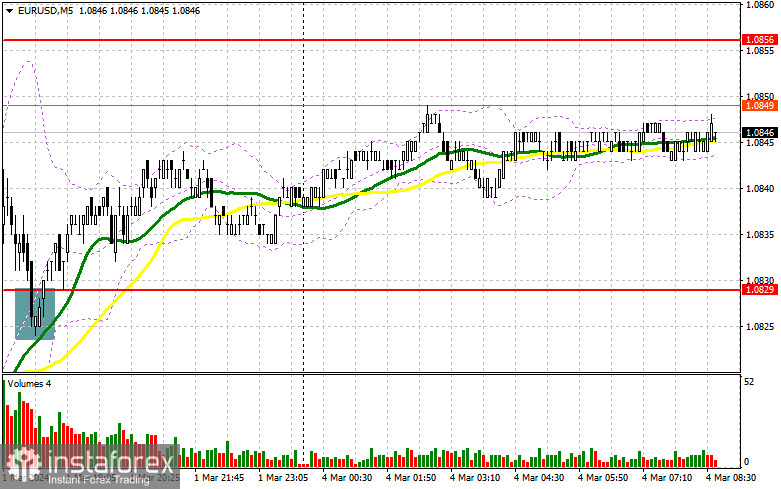Last Friday, only one signal was generated to enter the market. Let's take a look at the 5-minute chart and figure out what happened there. In my previous forecast, I paid attention to the level of 1.0797 and planned to make decisions on entering the market from there. EUR/USD actually declined to the area of 1.0797, but I did not detect any false breakout and test of this level. For this reason, there were no signals to enter the market in the first half of the day. In the afternoon, a breakout and reverse test of 1.0829 produced a buy signal, but the euro rose only by about 17 pips as volatility dropped significantly at the end of the day and week.

What is needed to open long positions on EUR/USD
Today we have no important statistics for the eurozone. Apart from data on the investor confidence indicator from Sentix for the eurozone, there is nothing that can influence market volatility. For this reason, I expect the continuation of Friday's trend. So, the bulls will attempt to get beyond the upper border of the side channel. In case of a decline in EUR/USD and a negative reaction to the economic data, I will act after a false breakout in the area of the nearest support 1.0829. This will be a proper condition for buying in anticipation of a further euro's continued growth to 1.0856. A breakout and top-down update of this range will lead to a new bullish trend, giving a chance to buy during a climb to 1.0886. The farthest target will be a maximum of 1.0931, where I will take profit. If EUR/USD declines and there is no activity in the area of the lower border of the side channel at 1.0829, the selling pressure on the euro will increase, which will lead to a larger drop with the prospect of updating 1.0797, the lower border of the side channel. I plan to enter the market there only after a false breakout has formed. I will open long positions immediately on a dip from 1.0763, bearing in mind an upward correction of 30-35 pips within the day.
What is needed to open short positions on EUR/USD
The bears were unable to maintain control over the market on Friday and now they need to try very hard to prevent the price from leaving the side channel. Weak statistics and unsuccessful consolidation above 1.0856 are a suitable condition for selling with the prospect of updating 1.0829, the middle of the side channel. A breakout and consolidation below this range, as well as a reverse test from bottom to top, will provide another selling point during a slide of the price to 1.0797. As a result, the sellers will regain the control over the market. The farthest target will be at least 1.0763, where I will take profits. If EUR/USD moves up in the first half of the day, continuing Friday's trend, and the bears do not show up at 1.0856, the buyers will retain an advantage by getting out of the channel. In this case, I will postpone selling until the test of the next resistance at 1.0886. I will also sell there, but only after unsuccessful consolidation. I plan to open short positions immediately on a rebound from 1.0931, bearing in mind a downward correction of 30-35 pips.

The COT (Commitment of Traders) report for February 20 showed an increase in long positions and a sharp decrease in short positions. Apparently, the statements of ECB policymakers had an effect, leading to a change in the balance of trading forces. However, there are still many more sellers, although this is a pretty good call for buyers of risky assets - especially on the back of the Federal Reserve's rhetoric, which remains hawkish. The COT report indicated that long non-commercial positions increased by 2,346 to 213,194, while short non-commercial positions fell immediately by 12,832 to 145,178. As a result, the spread between long and short positions decreased by 48.

Indicators' signals
Moving averages
The instrument is trading above the 30 and 50-day moving averages. It indicates a further rise in EUR/USD.
Note: The period and prices of the moving averages are considered by the analyst on the 1-hour chart and differ from the general definition of classic daily moving averages on the daily chart.
Bollinger Bands
In case EUR/USD goes down, the indicator's lower border at about 1.0815 will act as support.
Description of indicators
- Moving average (moving average, determines the current trend by smoothing out volatility and noise). Period 50. It is marked yellow on the chart.
- Moving average (moving average, determines the current trend by smoothing out volatility and noise). Period 30. It is marked green on the chart.
- MACD indicator (Moving Average Convergence/Divergence — convergence/divergence of moving averages) Quick EMA period 12. Slow EMA period to 26. SMA period 9
- Bollinger Bands (Bollinger Bands). Period 20
- Non-commercial speculative traders, such as individual traders, hedge funds, and large institutions that use the futures market for speculative purposes and meet certain requirements.
- Long non-commercial positions represent the total long open position of non-commercial traders.
- Short non-commercial positions represent the total short open position of non-commercial traders.
- Total non-commercial net position is the difference between short and long positions of non-commercial traders.





















